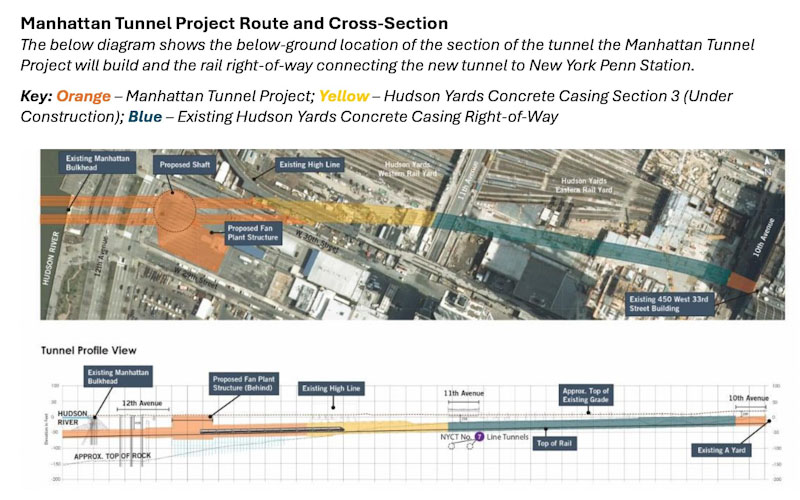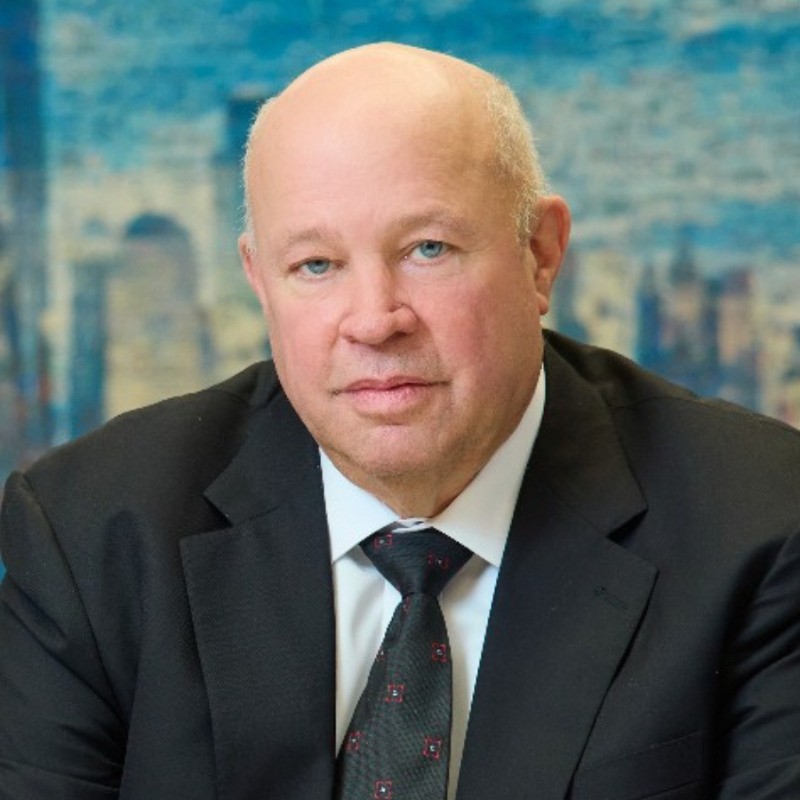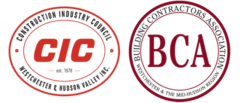Gateway Development Commission Awards $1.8 Billion Manhattan Tunnel Project to JV
NEW YORK—The Gateway Development Commission (GDC) Board of Commissioners awarded on Feb. 3 the contract for the Manhattan Tunnel Project to Frontier-Kemper-Tutor-Perini JV and authorized the notice to proceed with construction. The award the GDC Board approved includes $1.18 billion for the total contract price.
The commissioners also approved a Memorandum of Understanding (MOU) to the Project Labor Agreement previously approved by the Board with the unions that will be working on the project.
Construction of this portion of the Hudson Tunnel Project (HTP) is expected to begin in the coming months, with substantial completion anticipated in 2029. According to a preliminary estimate by EY (Ernst & Young), construction of the project will create 15,800 new jobs.

The Manhattan Tunnel Project will build the section of the new Hudson Tunnel Project tubes from the Manhattan Bulkhead in the Hudson River to the cut-and-cover Hudson Yards Concrete Casing east of 12th Avenue. The project will also remove obstructions that could slow or damage the tunnel boring machines digging the portion of the tunnel passing under the Bulkhead and into Manhattan and will protect and support existing features, including the Bulkhead and sewer lines.
In a joint statement, Alicia Glen, New York GDC Commissioner and Co-Chair, Balpreet GrewalVirk, New Jersey GDC Commissioner and Co-Chair, and Tony Coscia, GDC Amtrak Commissioner and Vice Chair, said, “The Manhattan Tunnel Project contract is an important step forward for the HTP that keeps us on pace to deliver the most urgent infrastructure project in the country. Even more important, it is a major win for workers. In the months and years ahead, this project will create thousands of good jobs and drive millions in economic activity. These workers will join the more than 7,500 construction workers who are already building other HTP projects. These men and women are working hard to deliver for us, and it is important that we keep this project moving forward for them.”
GDC CEO Tom Prendergast said, “I am proud to begin my tenure as CEO of GDC by awarding this contract to a highly qualified team that I am confident will successfully deliver this vital aspect of the HTP. The Manhattan Tunnel Project is one of the most technically complex pieces of the HTP. Building anything underground in Manhattan requires careful planning and expert execution, as I know from overseeing multiple subway expansion projects”
In total, the Manhattan Tunnel Project will require designing and building approximately 700 feet of twin 30-foot diameter tunnels. The portion to the east of 12th Avenue will be permanent. The portion between the Manhattan Bulkhead and 12th Avenue will be a temporary tunnel shell with the primary purpose of clearing the pathway for the future final tunnel to be installed by tunnel boring machines. The project also includes designing and building an access shaft at 12th Avenue that will ultimately be converted into a permanent ventilation facility for the new tunnel.
The Manhattan Tunnel project requires complex tunneling activities, including navigating multiple major sewer lines and live utilities, the Manhattan Bulkhead, and any other obstructions that the team may encounter and need to remove.
Due to the presence of historic fill along Manhattan’s western shore, obstructions could range from archeological findings to concrete slabs and debris. The project will also clear pile foundations remaining from both the West Side Highway that collapsed in 1973 and existing sewer utilities. To provide the flexibility needed to navigate these obstacles, the contractor has proposed excavating the tunnel using a protective digging shield. These methods would enable the majority of construction to take place underground, improving safety and significantly reducing the impacts of construction on surface roads and sidewalks.
In addition to the items related to the Manhattan Tunnel Project contract, the Board of Commissioners approved the creation of a stipend program to support the New Jersey Surface Alignment (NJSA) Project procurement process. This program will provide a stipend for work product to teams that submit bids for the NJSA Project but do not win the contract. Given the complexity of the NJSA Project, this stipend program is necessary to enable teams to invest the resources needed to prepare an innovative, price-certain responsive bid.
The NJ Surface Alignment project of the Hudson Tunnel Project will construct the new and expanded right-of-way adjacent to the existing Northeast Corridor (“NEC”), from the east side of County Road in Secaucus, NJ extending to the property west of Tonnelle Avenue and the Palisades Portal in North Bergen, NJ.
GDC will retain rights to the intellectual property, ideas, techniques, concepts, and approaches contained in all proposals from teams that receive stipends, and any other relevant work product that they create as part of the procurement process, GDC officials stated,
In the coming months, the commission expects to:
- Complete production of the tunnel boring machines (TBMs) that will build the New Jersey portion of the tunnel. These TBMs have already been ordered.
- Finish the Tonnelle Avenue Bridge and Utility Relocation Project. This will provide access to the portal to the Palisades that will enable tunnel boring machines to build the New Jersey portion of the new tunnel and will allow trains to pass under Tonnelle Avenue into the tunnel once it is in operation.
Seven of the 10 construction packages that make up the HTP are now under construction or in procurement. In total, construction of the HTP will create 95,000 jobs and generate nearly $20 billion in economic activity that benefits workers and businesses throughout the New York/New Jersey region and across the country. Work is well underway on three construction projects, including the first heavy construction project of the HTP. These projects are projected to create 7,500 jobs and generate $1.5 billion in economic output. In addition, initial construction in preparation for tunnel boring has launched and will advance significantly in the new year.
Ex-MTA CEO to Head Gateway Project
NEW YORK—The Gateway Development Commission announced it had appointed Thomas “Tom” Prendergast as Chief Executive Officer (CEO). The announcement was made at its Board meeting on Jan. 16.
Mr. Prendergast brings significant experience managing large rail infrastructure to the role, including serving as president, chairman, and CEO of the Metropolitan Transportation Authority; president of the Long Island Rail Road and CEO of the South Coast British Columbia Transportation Authority (TransLink).
At MTA, Mr. Prendergast led the way to securing a five-year capital plan to modernize New York’s public transportation systems and oversaw restoration of service after Hurricane Sandy and critical rehabilitation and flood resiliency efforts. He served as MTA CEO from December 2009 until January 2013.
Mr. Prendergast comes to GDC from AECOM, where he oversees design and consulting services across all business lines in New York and New Jersey, including transportation, water and wastewater, environment, power, and buildings and places.
In a joint statement, Alicia Glen, New York GDC Commissioner and Co-Chair, Balpreet GrewalVirk, New Jersey GDC Commissioner and Co-Chair, and Tony Coscia, GDC Amtrak Commissioner and Vice Chair, said, “Over the past year, we have moved from planning the HTP to building the nation’s most urgent rail infrastructure project. We are thrilled that Tom Prendergast will be at the helm of GDC’s operations as we continue to advance the construction projects that are already in progress and move forward with tunnel boring and trackway construction. The region, and the nation, need the Hudson Tunnel Project now more than ever, and Tom’s deep experience delivering complex infrastructure projects in New York and New Jersey, including his decades of work focused on rail mass transit in the region, position him perfectly to lead us through the next phases of this critical project.”

Published: February 13, 2025.
